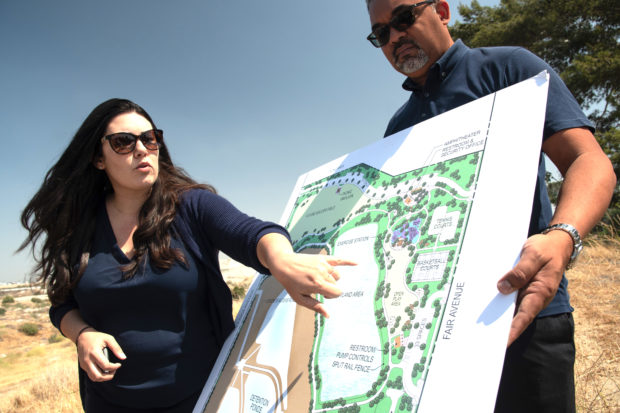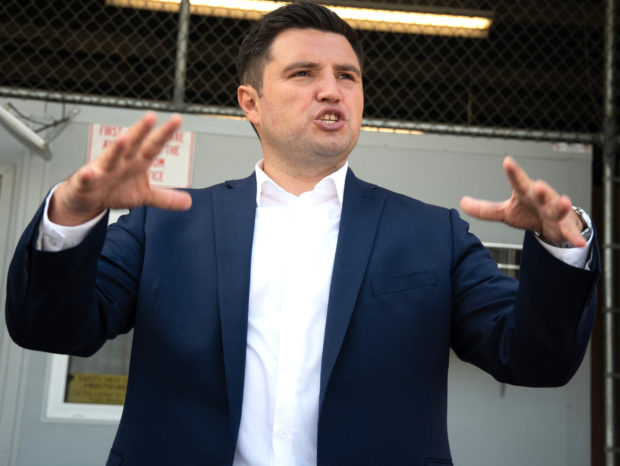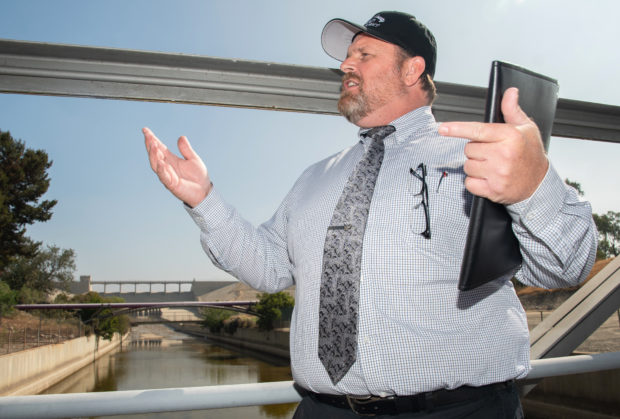Wanted: Upgrades in water works, more access to parks in LA County

Christine Wartman (left) and Kerjon Lee (right) of the LA County Department of Public Works describe the layout of the Rory Shaw Wetlands Park, a planned multipurpose flood control and recreation site that will be built near the corner of Cantara Ave and CaseSt. in Sun Valley. CONTRIBUTED
LOS ANGELES — Improvements to water infrastructure and access to public parks throughout Los Angeles County funded by a property tax hike are a critical investment in the future, according to the LA Department of Public Works (LA-DPW).
County’s Board of Supervisors on Tuesday, July 17, the will consider a funding measure developed by the Los Angeles Flood Control District (LA-FCD). The Safe Clean Water-LA Program would institute a new parcel tax to pay for projects designed to collect, clean and repurpose rainwater all over the County. The program intends to triple the current capacity for storm water recapture, while adding park space and new jobs throughout Los Angeles, according to spokespersons for the LA-DPW.

Los Angeles County Department of Public Works spokesperson, Edel Vizcarra, outlines the scope and purpose of the Safe Clean Water Program during a tour of the Hansen Spreading Grounds in Sun Valley, on Thursday, June 28. CONTRIBUTED
“Not only do we need more water, but we also need more open space,” said Strategic Communications Manager for the LA-DPW, Kerjon Lee. “One of the true benefits of this measure would also be cleaning up these beautiful community assets that we have, creating more open space for families to recreate and enjoy.”
The Sun Valley Recreation Center is one example of the multi-use facilities that might be built if the county moves forward with the Safe Clean Water Program. Aboveground, the park hosts youth sports programs and a variety of classes available to nearby residents. Beneath the public pool, baseball diamonds and soccer fields, a water quality treatment system collects and cleans storm water, which then either recharges local groundwater supplies, or is stored in two large infiltration galleries.
Work funded by the Safe Clean Water Program would be paid for by levying a parcel tax of 2.5 cent per parcel of non-permeable land. That would generate about $300 million annually and cost the typical single family homeowner about $80 a year, according to LA-DPW spokesperson Edel Vizcarra.
Low-income seniors, charitable organizations, and other specific groups would qualify for exemptions. In addition, property owners that set up their own storm water recapture systems may be eligible for a tax credit.
Vizcarra said projects would break ground as soon as 2020, coinciding with new environmental regulations associated with the Clean Water Act which take effect that same year. Money from the Safe Clean Water Program would ease the estimated $20 billion burden required over the next 20 years for the county and local municipalities to develop the infrastructure needed to stay within compliance.
“Most cities and the county have to pay for storm water programs out of their general fund,” said Vizcarra. “Those funds are limited. [Storm water projects] compete with police services and fire services.”

Senior Civil Engineer for the LA County Department of Public Works, Adam Walden, describes the vast nature of Los Angeles’s flood control system during a site tour of the Hendersen Spreading Grounds in Sun Valley, California on Thursday, June 28. CONTRIBUTED
These projects will require a skilled workforce to build, maintain and operate. Part of the money from the proposed parcel tax will be used to create job training programs near infrastructure sites so that newly created positions can be filled by local residents. The LA-FCD is working closely with a stakeholder advisory group to maximize the economic benefit of these projects for disadvantaged communities.
“In places like Sun Valley and the northeast valley that get heavily flooded, when it rains it limits people’s access to jobs and school,” said Carlos Moran, the director of Community Organizing and Engagement for the nonprofit Tree People.
He said that improving flood control infrastructure can have a dramatic impact on a community’s access to opportunity. In addition, green spaces help mitigate the urban heat island effect that occurs in paved cityscapes, helping to cool some of the hottest parts of the Los Angeles.
If the Board of Supervisors approves the measure, it will be added to the November 6 ballot and require approval from ⅔ of the County’s voters.

